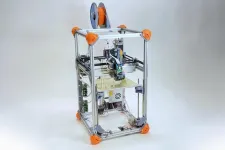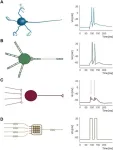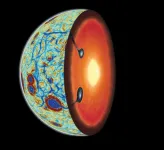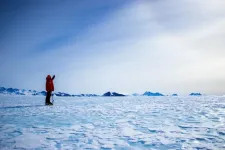(Press-News.org) SAN DIEGO – An investigational exosome-based liquid biopsy accurately detected 97% of stage 1-2 pancreatic cancers when combined with the biomarker CA 19-9, according to research presented at the American Association for Cancer Research (AACR) Annual Meeting 2024, held April 5-10.
“Pancreatic cancer is one of the most fatal malignancies, in large part because the majority of patients are diagnosed only after the cancer has already metastasized,” said Ajay Goel, PhD, senior author of the study and the chair of the Department of Molecular Diagnostics and Experimental Therapeutics at City of Hope.
While the five-year relative survival rate for patients diagnosed at the earliest stages—before the cancer has spread from the pancreas—is 44.3%, it is only 3.2% for those diagnosed with metastatic disease. “It is of utmost importance to diagnose patients as early as possible so they have the opportunity to receive potentially curative surgery and treatment,” Goel said.
Caiming Xu, MD, PhD, a postdoctoral fellow in Goel’s research group, added that early detection of pancreatic cancer remains challenging due to the nonspecific symptoms of the disease and because the pancreas is located deep within the abdomen, where it cannot be easily palpated during physical examination. Furthermore, existing biomarkers, such as CA19-9, are not reliable on their own to detect early-stage pancreatic cancer.
Goel, Xu, and colleagues explored the potential of an exosome-based liquid biopsy to detect pancreatic cancer at early stages. Liquid biopsies examine blood or other biological fluids for signs of cancer, such as genetic material or cells shed by tumors. The researchers developed a novel liquid biopsy approach that analyzed specialized vesicles called exosomes, which are shed by cancerous and healthy cells into blood. Exosomes shuttle molecular cargoes from one cell to another as a form of intercellular communication.
“Exosomes retain the cytoplasmic content of the cell from which they were shed, essentially replicating the biology of their tissue of origin,” Xu explained. The researchers identified eight microRNAs (small noncoding RNA molecules) that were uniquely found in exosomes shed from pancreatic cancers. They combined these with five cell-free DNA markers found in the blood of patients with pancreatic cancer to develop a signature associated with this disease.
The researchers previously tested the performance of their exosome-based liquid biopsy signature in a cohort of 95 individuals from either the United States or Japan, reporting a 98% pancreatic cancer detection rate. The latest study sought to evaluate the liquid biopsy in large, prospective cohorts from multiple institutions and countries.
The study enrolled individuals from:
Japan (150 with pancreatic cancer; 102 healthy donors);
the United States (139 with pancreatic cancer; 193 healthy donors);
South Korea (184 with pancreatic cancer; 86 healthy donors); and
China (50 with pancreatic cancer; 80 healthy donors).
The liquid biopsy signature was trained on information from the Japanese cohort and validated in the cohorts from the United States, South Korea, and China. Goel, Xu, and colleagues reported that their liquid biopsy approach detected:
93% of pancreatic cancers in the U.S. cohort;
91% of pancreatic cancers in the South Korean cohort; and
88% of pancreatic cancers in the Chinese cohort.
Further, when they combined their signature with the pancreatic cancer marker CA19-9, the liquid biopsy test accurately detected 97% of stage 1-2 pancreatic cancers in the U.S. cohort. Stage 1 pancreatic cancers are confined to the pancreas; some stage 2 cancers have spread to nearby lymph nodes but have not spread to distant sites.
“We have established an exosome-based signature that combines exosomal microRNAs and cell-free DNA to robustly identify patients with early-stage pancreatic cancer,” said Xu.
“Our approach offers a liquid biopsy test superior to CA19-9 measurement alone for early-stage disease,” Goel added. “Moreover, we evaluated the effectiveness of our assay in several different populations, including populations of different ethnic and geographical backgrounds.”
While additional research is needed before this test can be deployed to the general population, the researchers noted that it might benefit certain groups with a high risk for pancreatic cancer, such as those with chronic pancreatitis, new-onset diabetes, or a family history of pancreatic cancer.
A limitation of the study was the limited number of Black individuals included in the study cohorts. Another limitation was the lack of an established microRNA control against which to normalize the levels of candidate microRNAs used to develop the signature.
The study was supported by the National Cancer Institute of the National Institutes of Health. Xu and Goel declare no conflicts of interest.
END
An exosome-based liquid biopsy shows promise for early detection of pancreatic cancer
2024-04-08
ELSE PRESS RELEASES FROM THIS DATE:
Proof-of-principle demonstration of 3-D magnetic recording
2024-04-08
1. Research groups from NIMS, Seagate Technology, and Tohoku University have made a breakthrough in the field of hard disk drives (HDD) by demonstrating the feasibility of multi-level recording using a three-dimensional magnetic recording medium to store digital information. The research groups have shown that this technology can be used to increase the storage capacity of HDDs, which could lead to more efficient and cost-effective data storage solutions in the future.
2. Data centers are increasingly storing vast amounts of data on hard disk drives (HDDs) that use perpendicular ...
This 3D printer can figure out how to print with an unknown material
2024-04-08
While 3D printing has exploded in popularity, many of the plastic materials these printers use to create objects cannot be easily recycled. While new sustainable materials are emerging for use in 3D printing, they remain difficult to adopt because 3D printer settings need to be adjusted for each material, a process generally done by hand.
To print a new material from scratch, one must typically set up to 100 parameters in software that controls how the printer will extrude the material as it fabricates an object. Commonly ...
Brain-inspired computing may boil down to information transfer
2024-04-08
The biological brain, especially the human brain, is a desirable computing system that consumes little energy and runs at high efficiency. To build a computing system just as good, many neuromorphic scientists focus on designing hardware components intended to mimic the elusive learning mechanism of the brain. Recently, a research team has approached the goal from a different angle, focusing on measuring information transfer instead. Their method went through biological and simulation experiments and then proved effective in an electronic neuromorphic system. It was published ...
Youths with mood disorders 30 percent less likely to acquire driver’s license than peers
2024-04-08
Philadelphia, April 8, 2024 – Researchers from Children’s Hospital of Philadelphia (CHOP) found that teens and young adults with mood disorders, such as depression and bipolar disorder, were 30% less likely to obtain their driver’s license than peers without such disorders. Additionally, those youths with mood disorders experienced a slightly elevated risk of crashing. These findings suggest that these teens and young adults could benefit from guidance on obtaining licensure and accessing training to avoid crashes when they are newly licensed.
The findings were published online today ...
Opening a new front against pancreatic cancer
2024-04-08
NEW YORK, NY (April 8, 2024)--A new type of investigational therapeutic in development for pancreatic cancer has shown unprecedented tumor-fighting abilities in preclinical models of the disease, suggesting it has the potential to offer novel treatment options for nearly all pancreatic tumors, a comprehensive study has found.
The inhibitors in this new class of oral medications, being developed by Revolution Medicines Inc., target the oncogenic or active cancer-causing form of RAS proteins (such as KRAS, NRAS, and HRAS). These RAS “oncoproteins” drive up to a third of all human cancers. The research ...
More premature babies born following Swedish parental leave policy
2024-04-08
The introduction of a policy protecting parental leave benefits in Sweden in 1980 had unintended consequences on child health. The policy led to an increase in premature birth rates. This is shown by a study from researchers at Stockholm University, published in JAMA Pediatrics.
The Swedish so-called speed premium policy was introduced in 1980 in order to protect couples’ level of income-based parental leave benefits when they had children in quick succession. The new study from Stockholm University evaluates the health consequences of the policy. The researchers conclude that by ...
Immune key to chronic viral infections discovered
2024-04-08
IMMUNE KEY TO CHRONIC VIRAL INFECTIONS DISCOVERED
Australian researchers have discovered a previously unknown rogue immune cell that can cause poor antibody responses in chronic viral infections. The finding, published today (9 April) in the journal, Immunity, may lead to earlier intervention and possibly prevention of some types of viral infections such as HIV or hepatitis.
One of the remaining mysteries of the human immune system is why a certain cell, called a B cell, which retains a memory for past infections – ensuring we fight off diseases we have experienced before – often only has a weak capacity to protect us from persistent infections.
Researchers ...
PFAS ‘forever chemicals’ above drinking water guidelines in global source water
2024-04-08
Per-and poly-fluoroalkyl substances – commonly known as PFAS – are a group of over 14,000 human-made chemicals that have been popular since the 1950s for their diverse skills in resisting heat, water, grease and stains.
They’ve been commonly found in household products like non-stick frypans, clothing, cosmetics, insecticides, and food packaging, as well as specialty industry products, like firefighting foam.
But despite their broad skillset, the chemicals have a dark side: they’re known as ‘forever chemicals’ as once they’re in the environment – ...
How the moon turned itself inside out
2024-04-08
About 4.5 billion years ago, a small planet smashed into the young Earth, flinging molten rock into space. Slowly, the debris coalesced, cooled and solidified, forming our moon. This scenario of how the Earth's moon came to be is the one largely agreed upon by most scientists. But the details of how exactly that happened are "more of a choose-your-own adventure novel," according to researchers in the University of Arizona Lunar and Planetary Laboratory who published a paper in Nature Geoscience. The findings offer important insights into the evolution ...
Climate change threatens Antarctic meteorites
2024-04-08
Using artificial intelligence, satellite observations, and climate model projections, a team of researchers from Switzerland and Belgium calculate that for every tenth of a degree of increase in global air temperature, an average of nearly 9,000 meteorites disappear from the surface of the ice sheet. This loss has major implications, as meteorites are unique samples of extraterrestrial bodies that provide insights into the origin of life on Earth and the formation of the Moon.
Disappearing at an alarming rate
By 2050, about a quarter of the estimated of 300,000 - 800,000 meteorites in Antarctica will be lost ...




